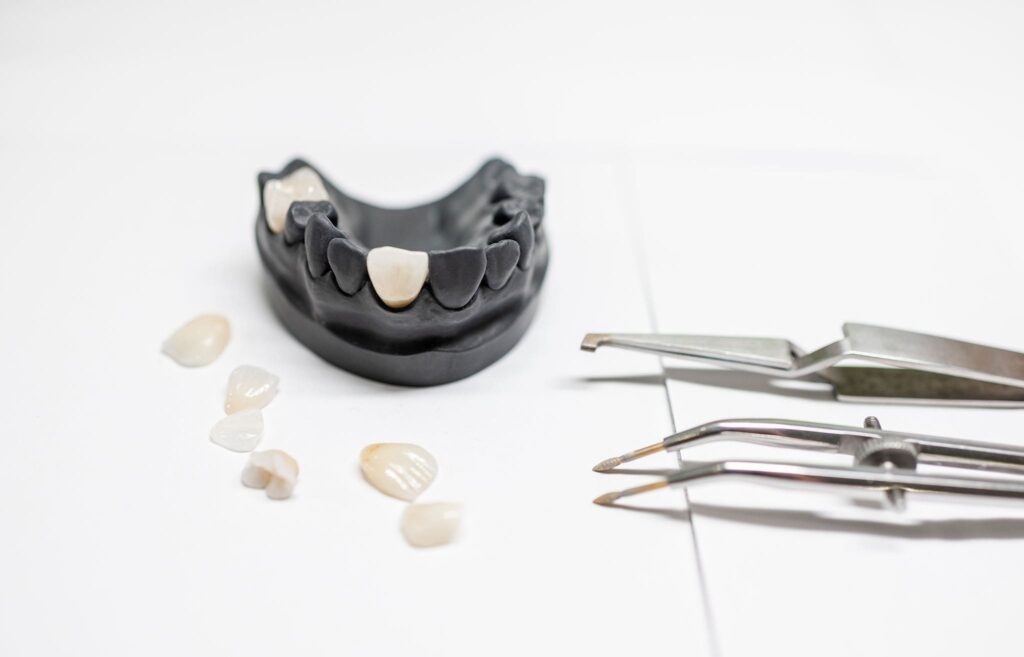
Dental Prostheses
Dental Prostheses are a method of dental treatment that allows the restoring of damaged or lost teeth. The use of modern prosthetic methodology provides an opportunity to correct any dental problems using prostheses, from small cracks to loss of the entire dental arch.
- Dental prosthetics procedure
- Types of dental prostheses
- Veneers
- 3D Digital Teeth Modelling
- When are dental prostheses required?
- How painful is dental prosthetics procedure?
- What are dental prostheses made of?
- Teeth straightening after dental prosthetics
- Maintenance and care of dental prostheses
- Dental prosthetics in our clinic
- Frequently asked questions
- Pricelist
Dental prosthetics procedure
1 – Oral inspection and diagnosis
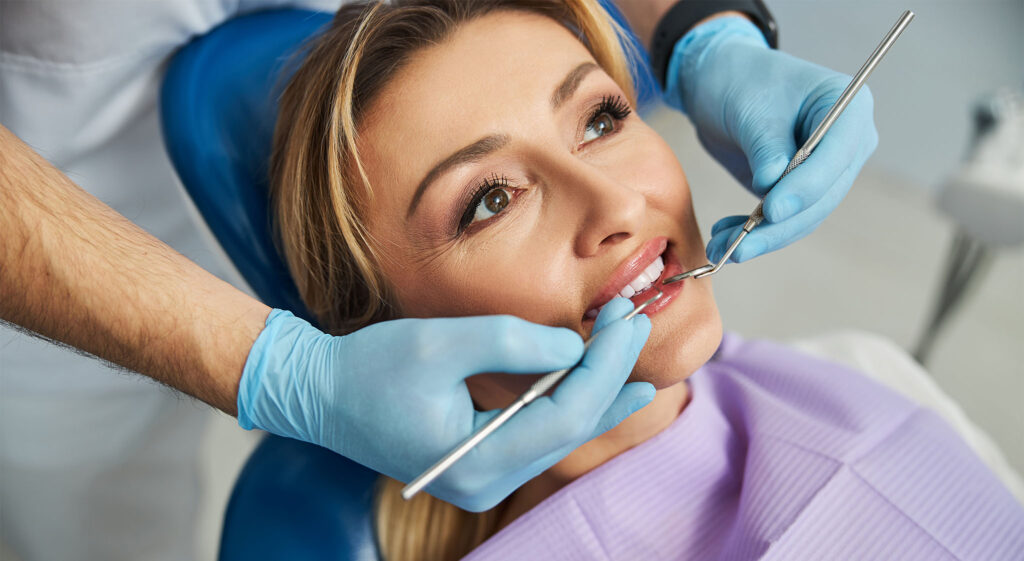
Before prostheses’ can be fitted, the patient will undergo an oral inspection, radiodiagnosis and a digital examination, all performed during the initial consultation. The condition of the teeth and possible other treatment methods are discussed after the inspection. A detailed treatment plan is developed based on the patient’s personal treatment preferences and their clinical needs. Before the prostheses are designed, all procedures are planned and agreed upon with the patient to ensure the best results. These plans often cover therapeutic, periodontal and orthodontic treatments.
2 – Preparation for the procedure
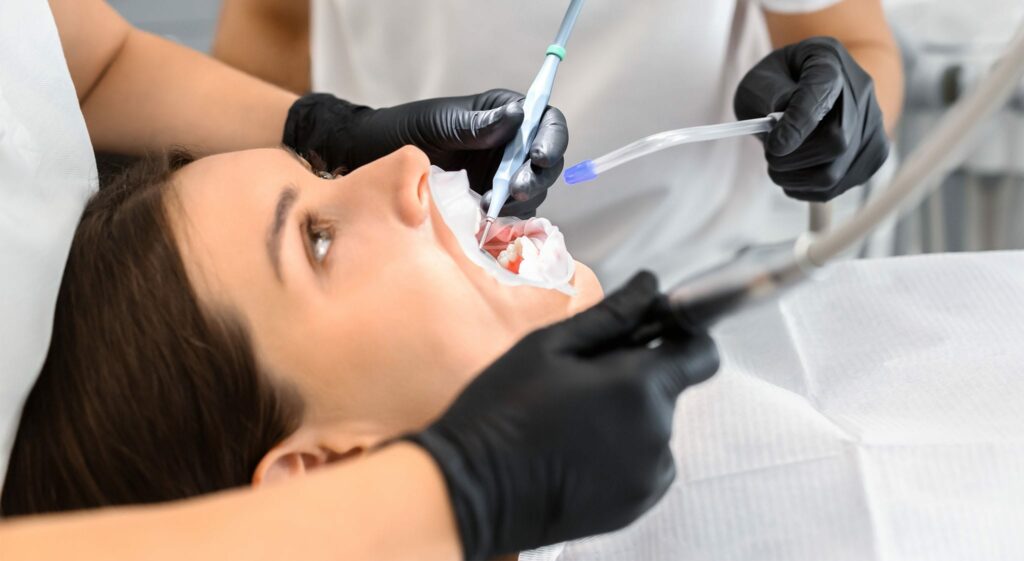
Depending on the condition of the patient’s teeth, a list of preparatory dental procedures are required/recommended before fitting the prostheses:
- Professional oral hygiene appointments.
- Orthodontic treatment using braces or aligners in cases where a bite defect is present.
- Treatment of any root canals. After endodontic treatment, the tooth is often restored with a dental crown or overlay.
- Surgical treatment may be necessary in some situations: Bone augmentation before installation of the implant, Treatment of any gum recession or any other operations required for the given clinical case.
- Teeth Whitening. This cosmetic procedure is not required and is only performed if the patient requests it. As the white level of prostheses remains permanent, we recommend that you perform teeth whitening before your dental prosthetics are created. The shade of the prosthesis is then chosen for the already whitened teeth.
3 – Prosthesis Modelling
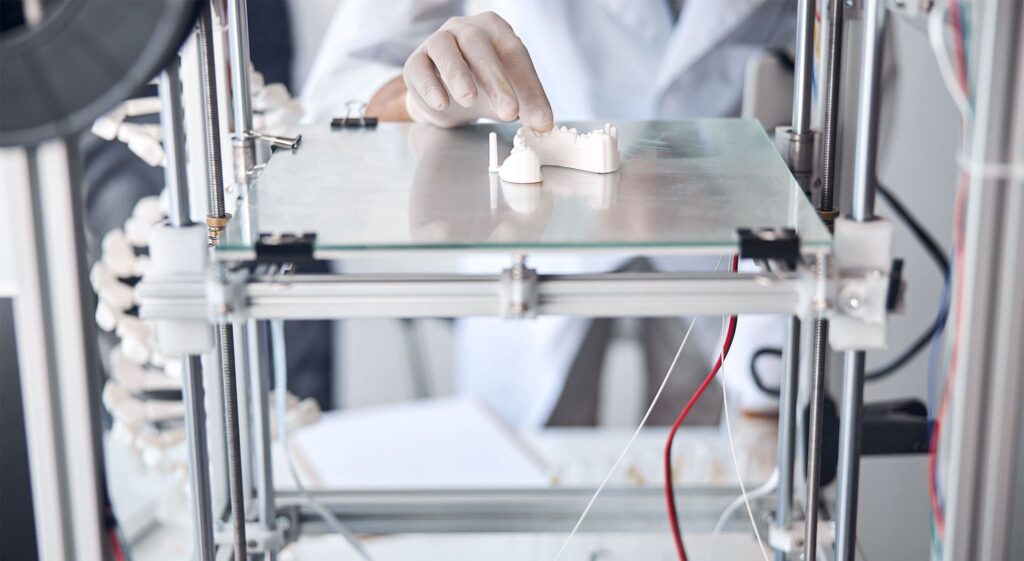
A digital image of the patient’s teeth is acquired by scanning the mouth with a special 3D scanner. This digital model ensures a significantly faster production speed as well as ensuring its highest quality. The scanning procedure is significantly more pleasant for the patient compared to dental impressions. The 3D model is then sent to a laboratory where the prostheses are made. The production time depends on its type, the severity of the patient’s dental condition (the complexity of the prosthesis) and the material used. During this stage, the patient also has the opportunity to see a digital model of their future smile.
4 – The procedure
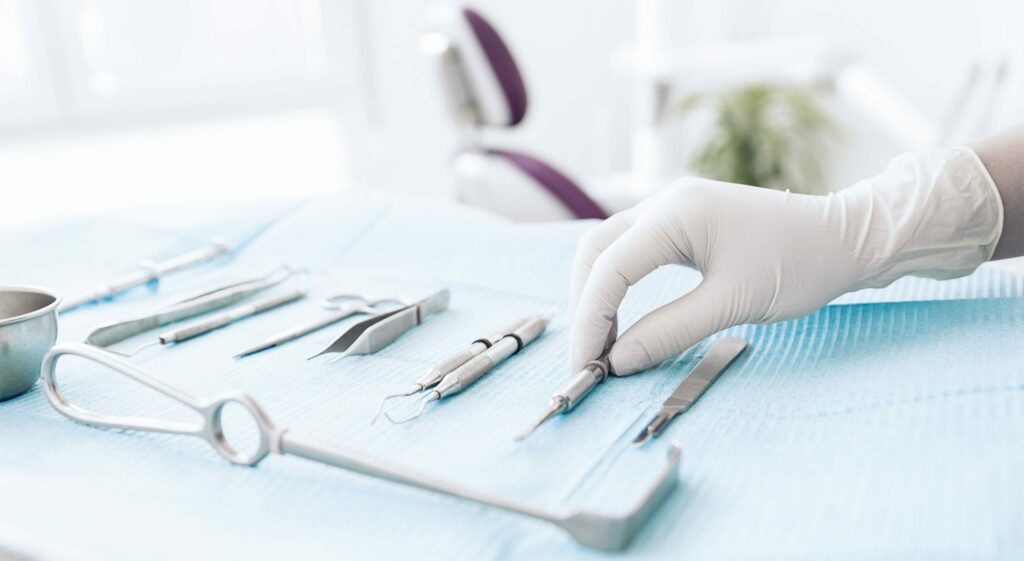
When the prostheses are ready, the patient is scheduled for the procedure. Depending on the type of prostheses, and the condition of the patient and their teeth, one of the following prosthetics technologies is selected:
- When performing tooth crowning, the tooth is shaved around its centre with special drills. In cases when the inner part of the tooth has been damaged by pulpitis, or the hard surface of the tooth is not sufficient to support the crown, the root canals are treated and filled. The crown is installed on the tooth and fixed with special dental cement.
- When using overlays/inlays, the damaged tooth’s surface is polished. The surface of the tooth is cleaned to ensure better adhesion of the prosthesis. The prosthesis is then installed on a cement filler.
- For the installation of implants, one procedure is usually enough. An implant is installed into the bone tissue of the removed tooth, and an artificial crown is attached.
When the tooth is prepared for prosthetics in advance (e.g., shaved), a temporary prosthesis is installed which ensures the functionality and aesthetic of the tooth until a permanent prosthesis can be fitted.
5 – Postoperative period
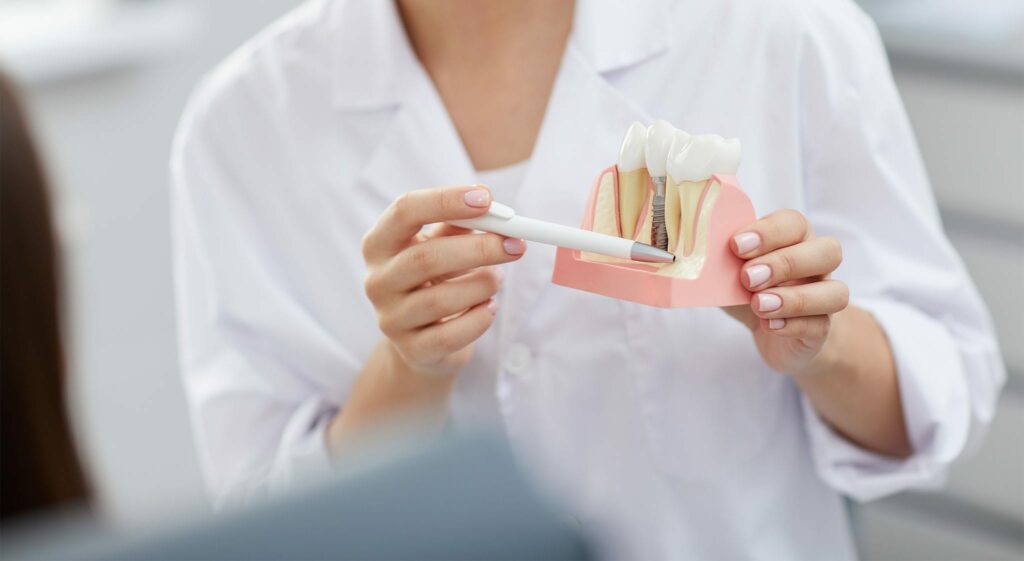
It is very important to monitor the prostheses after the procedure. Specific maintenance instructions apply to each type of prosthesis and the dentist will provide recommendations regarding the adaptation period, the frequency of follow-up visits, and oral hygiene. It is important to remember that, despite the fact that prostheses cannot be damaged by bacteria, the tissues around the prosthesis remain natural and require regular cleaning and professional dental care.
Types of dental prostheses
Different types of prostheses offer various reconstruction possibilities. Overlays and inlays can cover small surface defects of the molars. Crowns can cover more than 50% of the damaged tooth. Implants can be used to fully restore a lost tooth.
Innovative digital scanning and prosthesis modelling technologies allow for quick reconstruction, ensure high accuracy and durability. It is also possible for the patient to view a digital model of their future smile before the procedure is performed.
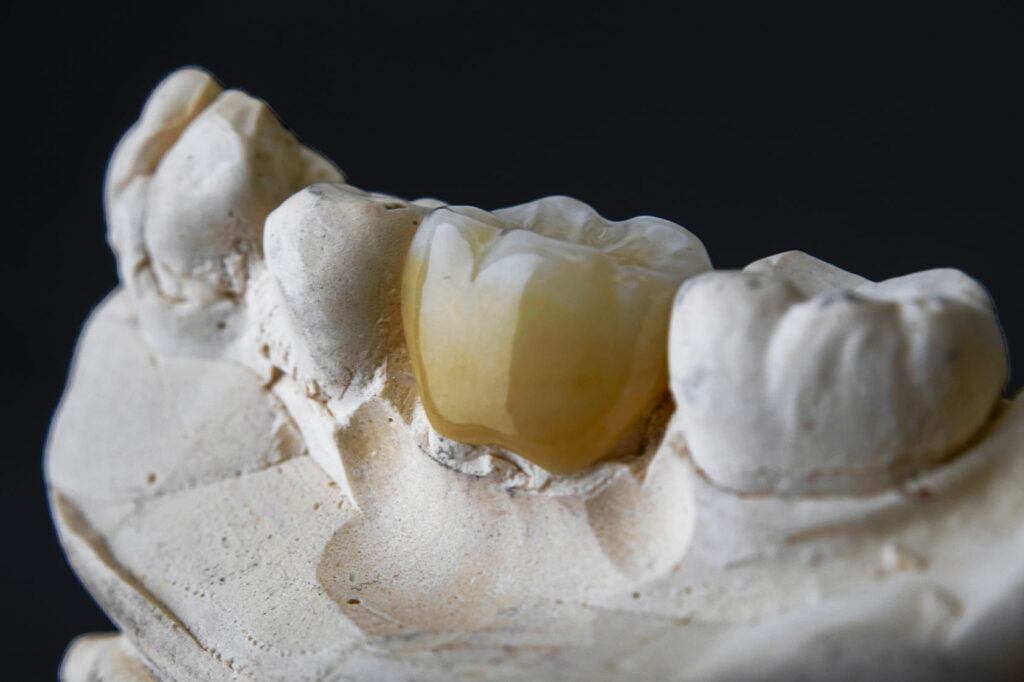
Crowns
A dental crown is a prosthesis designed to cover a whole tooth or a part of its surface. Crowns are applied to tooth defects that cannot be restored by a less invasive method. They allow changing the shape, position and colour of the tooth. When installing a dental crown, the tooth is shaved to the required shape. A 3D dental scan is performed before the procedure. The 3D dental model is then used by dental technicians in the laboratory to produce temporary plastic crowns and then permanent ceramic ones.
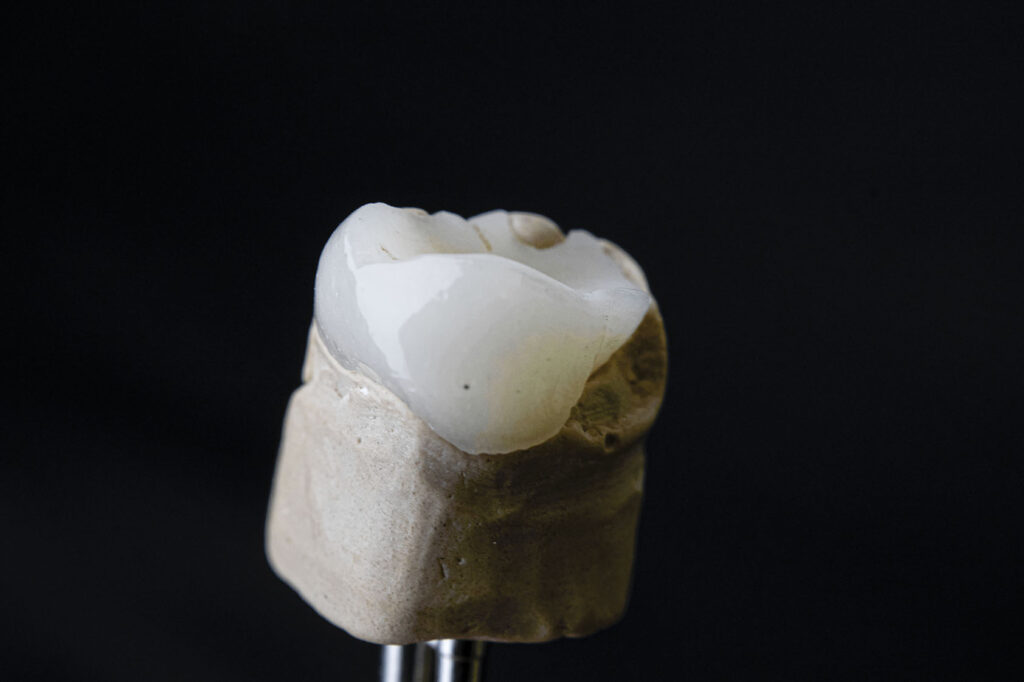
Overlays and inlays
Overlays and inlays are designed to restore parts of the molars’ surface. They are made in the laboratory by a dental technician from either special metals, composite materials or ceramic composites.
- The inlay is fixed inside the tooth. It is similar to a dental filling and is used to fix extensive tooth damage such as larger cavities.
- The overlay partially, or completely covers the tooth and is used to restore the contact surface of the tooth.
Dental fillings and inlays can restore the exact shape of the tooth and strengthen it, which protects the tooth from micro-cracks and decay. With this method of prosthetics, it is not necessary to shave the tooth as is required for dental crowns. The colour palette of our ceramic overlays, and inlays, ensures a high-quality aesthetic appearance for your teeth.
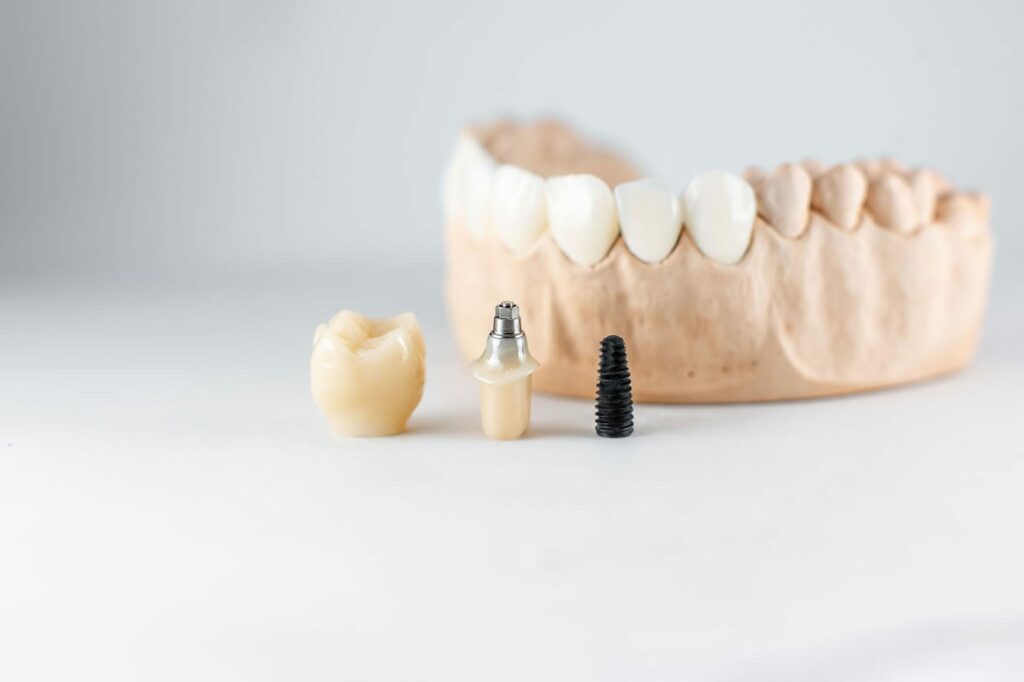
Dental implants
There exists a misconception that an implant is a „complete tooth“. In fact, the implant is made of an artificial root and a separate ceramic crown. A titanium screw with a diameter of 3 to 5 mm is implanted in the bone tissue and then a ceramic tooth crown is installed onto it. Dental implants do not cause allergies and almost never get ejected by the human body. One of the advantages of this treatment method is that it does not require shaving the adjacent teeth. It is possible to use multiple implants to restore several adjacent lost teeth or the entire jaw at once.
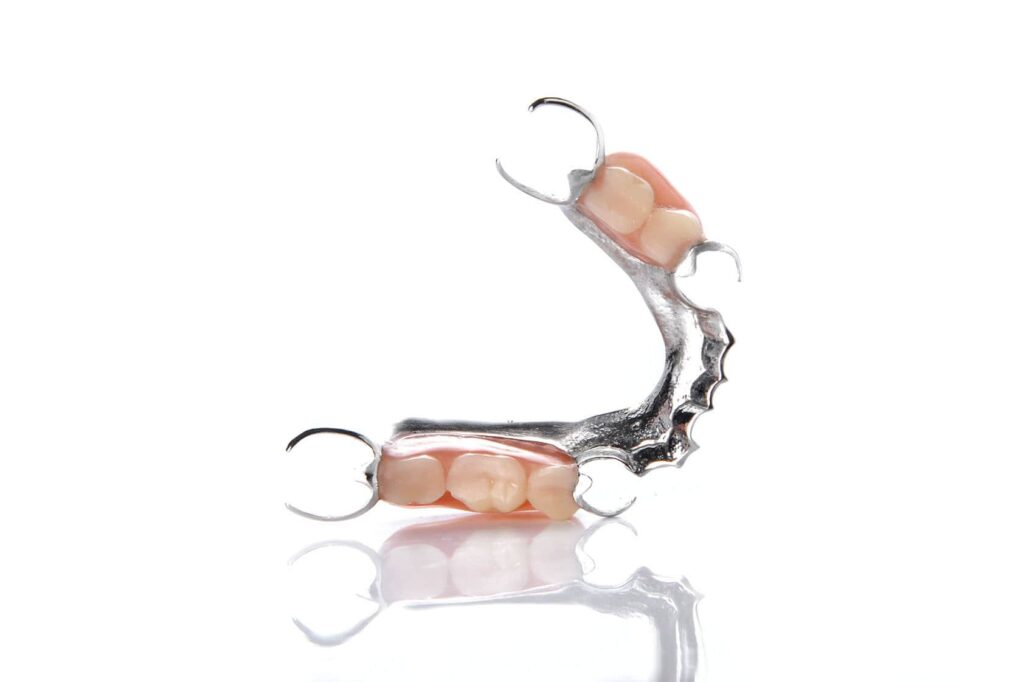
Dentures
Removable dentures are used when many, or all, teeth in the dental arch are missing. Dentures are also often chosen as a temporary method of prosthetics. The plates are made of polymeric materials onto which artificial teeth crowns are attached. Dentures are held in the mouth by attaching to the soft tissues and adjacent natural teeth.
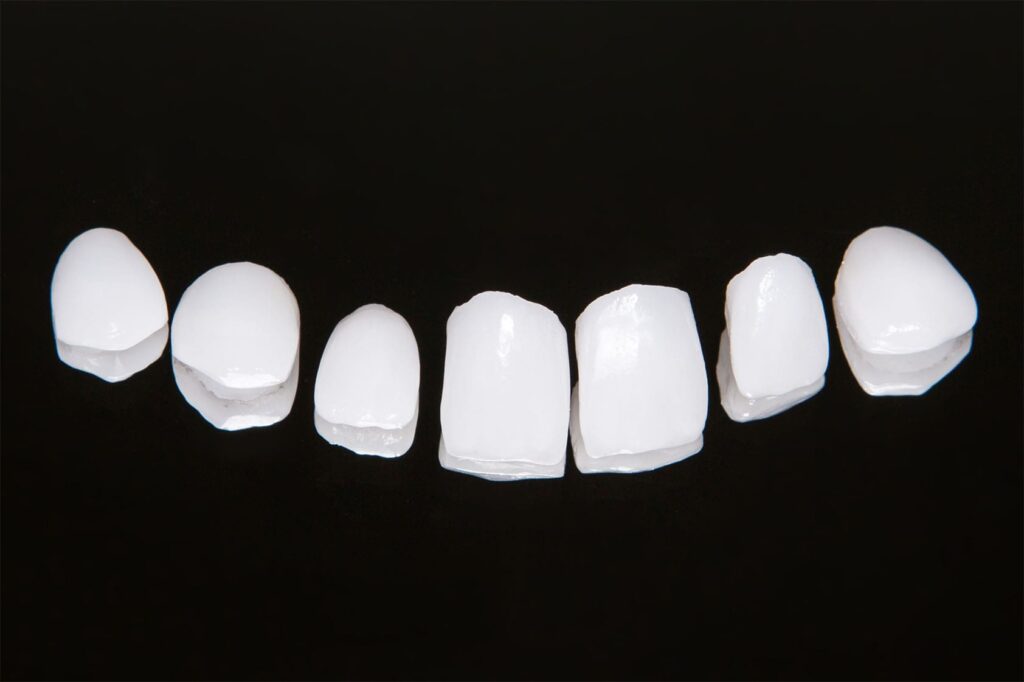
Veneers
Veneers are very thin (up to 0.5 mm) ceramic, or porcelain, plates that replace the front of the tooth’s surface. They do not require as much polishing of the teeth when compared to other methods. They are most commonly used to restore the front teeth for cosmetic reasons. Veneers can also be used instead of traditional orthodontic treatment when there are only minor tooth irregularities. This type of prostheses can be used as an alternative to cosmetic dental fillings.
3D Digital Teeth Modelling
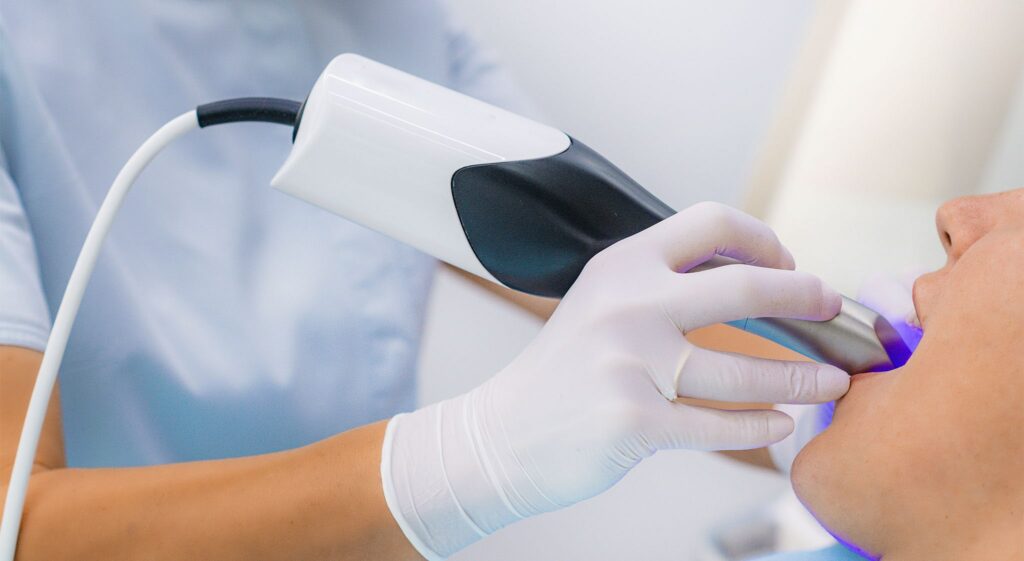
One of the most advanced technologies in modern dentistry is digital dental scanning, where an advanced 3D intraoral scanner is used to get a detailed model of the mouth. The 3D model is then sent to dental technicians, who make a prosthesis tailored specifically for the patient. 3D dental scanning allows the production of precise dental prostheses. Prostheses made using the 3D scan accurately restore the natural shape and colour of the teeth, are more durable and comfortable.
What is more, the digital dental scanning procedure is simpler compared to taking traditional dental impressions. A tool with small cameras is used to produce a 3D digital scan of the mouth. This type of scanning does not cause nausea or another discomfort. Computer dental modelling allows dental technicians to programmatically create an image and view the future prosthesis in a patient’s mouth.
When are dental prostheses required?
Dental prostheses are installed when one or more teeth have been extracted, cracked or damaged. Prostheses are also installed after endodontic treatment has been performed and the tooth pulp has been filled, or for cosmetic purposes that cannot be achieved by other means. Installation of dental prostheses involve the extraction of a natural tooth (or teeth) or shaving down existing teeth, which means our first goal is always to try and heal the tooth and restore its’ shape with other, less invasive, methods.
However, this does not mean that prostheses are harmful to the natural ecosystem of the mouth. Prosthetics offers an opportunity to solve even the most difficult of dental cases, which cannot be treated by other means. Dental prostheses allow patients who have lost their teeth to start smiling with a full-blown smile again.
Dental prosthetics are the only way to restore lost teeth. However, the need for prosthetics in the treatment of functional teeth is determined individually, as each clinical case is unique. Only a dentist, who has thoroughly examined the patient’s dental condition, can determine the most effective treatment method.
How painful is dental prosthetics procedure?
Fitting dental prostheses is not painful as, in all cases of mechanical teeth treatment or installation of prostheses, the patient is offered some sort of anaesthesia.
However, since prostheses are a foreign body in the mouth, they can initially cause some discomfort. It is normal to feel a headache or pain in the area around the implant or jaw for up to 2 weeks after dental implantation. Other types of prostheses usually cause only minor discomfort, which the patient gets used to after only a few days.
What are dental prostheses made of?
Modern dental prostheses can be made of many different materials. The choice of a prosthesis’ material depends on the clinical case (tooth position, damage degree, etc.) and the patient’s personal preferences (e.g., the desired teeth colour). The most commonly used prostheses are made of the following high-quality components:
- Titanium – Often used to make dental implants as it is one of the best materials for fusion with the dental bone.
- Metal ceramics – Very durable but have little aesthetic appeal, better for back teeth restorations.
- Non-metallic ceramics (porcelain) – These have more aesthetic appeal, frequently used for front teeth restorations.
- Zirconium oxide ceramics – These have one of the higher levels of aesthetic appeal as well as being one of the more durable materials. Due to this, they are used for a large amount of modern prostheses.
- Glass-ceramics – These are made from the most visually pleasing material available, but prostheses made of glass-ceramics are significantly less durable than zirconium oxide or porcelain ceramic ones.
Teeth straightening after dental prosthetics
Teeth straightening is usually possible after dental prostheses are fitted. Orthodontic brace constructions can be placed on teeth with crowns or any other type of restoration with natural roots. Natural tooth roots are movable, and reliable attachment of the prosthesis to a tooth allows braces or dental aligners to be installed on top.
Dental implants are installed into the correct natural teeth positions. Straightening of teeth is also possible with implants if fixation of the latter is ensured when installing orthodontic constructions.
Maintenance and care of dental prostheses
Prostheses are made from artificial materials that cannot be damaged by bacteria. However, this doesn’t mean you don’t need to brush as they do not protect the tissues around them from the buildup of plaque and the effects of pathogenic microorganisms. It is also important to thoroughly clean prostheses together with all other teeth and to protect them from mechanical damage.
Improper oral hygiene with an implant can lead to peri-implantitis, an inflammation of the tissues around the implant. Patients with implants are advised to provide extra oral hygiene care and get a professional oral hygiene service more frequently.
Dental prosthetics in our clinic
The extensive experience and treatment skills of the dental prosthetist, supplemented by the use of the most effective modern technologies, is the recipe for a successful dental restoration. This is exactly what patients get offered in our clinic.
Our dentists will perform a professional oral inspection, respond to the patient’s wishes during the consultation, perform all the preparatory procedures with the highest quality and select the best treatment plan to achieve the best teeth restoration possible.
Our main goal is to see the healthy and aesthetic smiles of our patients. Therefore, we always perform the highest quality dental prosthetics and other dental services.
Frequently asked questions
Pricelist
Dental prosthetics
| Metal ceramic crown | 520 € |
| Glass-ceramic crown | 620 € |
| Zirconia ceramic crown | 750 € |
| Monolithic zirconia crown | 650 € |
| Individually laminated glass-ceramic veneer | 700-900 € |
| Temporary dental prosthesis made in the clinic | 100 € |
| Tooth restoration with a fibreglass pin and composite | 150 € |
| Removal of an old MC crown | 35 € |
| Recementation of a loose crown | 35 € |
| Waxing (1 tooth) | 35 € |
| Silicone guide | 60 € |
| Removal of a stamped crown | 6 € |
| Partial denture (up to 3 teeth) | 250 € |
| Partial denture (up to 6 teeth) | 500 € |
| Full denture (whole single jaw) | 800 € |
| Temporary high-aesthetic prosthesis | 110 € |
| Installation of a mesh in denture | 120 € |
| Installation of a tooth in denture | 60 € |
| Temporary crown on implant | 200 € |
| Individually produced titanium/zirconium implant support | 200 € |
| Multi-unit | 200 € |
| Fixed 4-implant prosthesis (cast chrome cobalt frame with acrylic or composite teeth) | 3000 € |
| Fixed 4-implant prosthesis (milled titanium frame with acrylic or composite teeth) | 4000 € |
| Fixed 4-implant prosthesis (titanium/zirconium frame, ceramics) | 6500 € |
| Overlay prosthesis | 650 € |
| Bruxism guards | 350 € |











